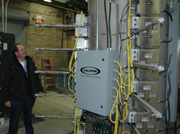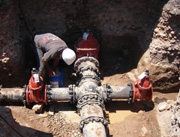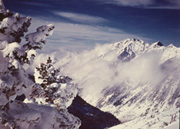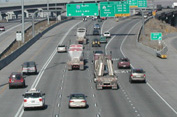Director’s 2006 Year End Report
Public Utilities Advisory Committee Meeting
November 30, 2006
LeRoy W. Hooton, Jr.
|
The Committee has been in place since 1979 and has made an enormous contribution to the Department’s success by providing citizen input. The expertise represented by the Committee members is outstanding.
Mr. Hooton expressed his appreciation for each and every employee in the Department, noting that everyone is important and everyone has contributed to the Department’s success.
He told the Committee that the Department has complied with all regulatory requirements during the past year under the Clean Water and Safe Drinking Water Acts.
During the past year the Department’s customer service received the highest overall rating since the survey was first initiated about 15 years ago. Written comments regarding both office and field personnel indicate satisfaction with their performance.
The storm water utility was highlighted in the December issue of Water and Sewer Magazine. The article thoroughly covered the many storm water programs that minimizes urban water pollution and keeps the City in compliance with its NPDES permit requirements.
Mr. Hooton said that he wanted to focus on four topics.
1. Groundwater contamination
|
Since 1988 there have been 4 wells contaminated with PCE. Two of the wells have been equipped with treatment processes to totally remove the chemical from the drinking water supply.
Last year PCE was found in the 500 South Well adjacent to the University of Utah campus. The well is out of service until treatment can be installed.
This year it appears that PCE is in the groundwater of the 1900 East 2700 South Well. After reviewing the options, it has been decided to install a new pipeline to convey other sources of water supply into the well’s service zone.
It takes very low concerntrations of PCE to contaminate the groundwater and indeterminate years to treat and/or remove it.
2. Infrastructure
|
The $17 million Mill Creek SID is near completion. Public Utilities contributed $3 million to the project, which consists of installing nearly 100,000 linear feet and adding several hundred new fire hydrants in the Mill Creek area.
The water, sewer and storm water systems have an estimated replacement value of $2.4 billion. Capital investments from 1990-2006 amounted to $364 million in system improvements, which amounts to just less than 1 percent per year. With this rate of replacement it assumes that the infrastructure will last 100 years on top of the existing aging system.
The cost of replacing water mains is increasing at a rate faster than inflation. The cost to replace an 8-inch water main increased from $31.89 and to $96.28 per linear foot of pipe in 2006; increasing 2.66 times faster than the rate of inflation since 1986.
The Department is using new technology to reduce the cost of rehabilitating aging sewer pipelines. By using cast-in-place-pipe (CIPP) the cost has been reduced from $175.00 per linear foot to $21.00. The Department is currently rehabilitating about 60,000 linear feet of sewer pipe per year.
3. Watershed Protection
|
There are growing pressures on the canyon watersheds. There are efforts to transfer water up-canyon for development; RS 2477 Road issues, and more recently the renewal of the effort to construct a ski interconnect with tunnels. The interconnect was first proposed in the late 1980s. It was opposed by the City and failed to materialized. These endeavors if successful, will forever change the canyon watersheds.
On the other hand there are a number of great things the Department is accomplishing in the watersheds under the “Keep It Pure” program.
The Department has under contract to purchase about 150 acres of watershed property in the South Fork, Mill D in Big Cottonwood Canyon. Since 1991, not counting the pending purchase, the Department has acquired 1,254 acres of watershed at a cost of $4.97 million.
The Department has focused on information and education programs. Working with the school districts, watershed programs have been developed for 4th and 9th grade students. Text books have been developed and teachers are currently being trained. This educational effort will be taken into schools in the Salt Lake valley.
Other programs include on-site education. In conjunction with the Cottonwood Foundation, children participate in various canyon education programs. Watershed employees participated in the Water Quality Fair at Hogle Zoo and the Wasatch Wild Flower Festival held in Little Cottonwood Canyon.
The Department has initiated an invasive weed program within the watersheds. This year the program was kicked off with a ton of Dyers Woad being pulled and removed from City Creek.
4. Water Conservation: per capita consumption calculation
|
The State of Utah uses per capita consumption to set and measure conservation goals. Likewise the Central Utah Water Conservancy District, in petitions for ULS water, requires conservation based on per capita reduction goals, with penalties.
A 2000 Census report ranks Salt Lake City number three in commuter-to-city resident ratio of cities of its size or larger nationwide. With the population growth projections along the Wasatch Front, the number of non-residents using city water will only increase, placing even a greater burden on the City’s permanent resident population to achieve conservation goals.
Fifty-eight percent of water consumption in Salt Lake City’s water service area (including the county) is by permanent resident users. The remaining 42 percent of the usage is for non-resident uses. As can be seen there is a large volume of the water consumed for which there is no population to use in the calculation.
The Metropolitan Water District of Salt Lake & Sandy conducted a study using the Wasatch Front Regional Council population and employment projections data. The data showed that the City’s net transient workforce amounted to 131,679 people. Further, the study determined that one transient worker equals 0.233 permanent residents. Using this rationale, it is possible to accurately account for the non-resident population water use within the City’s service area. The Department has requested the Division of Water Resources adopt a model that will take into account non-resident water consumption in the calculation of per capita consumption.
Mr. Hooton concluded, on behalf of the Senior Leadership team and all of the Department’s employees, wishing everyone a Merry Christmas and a Happy New Year.




